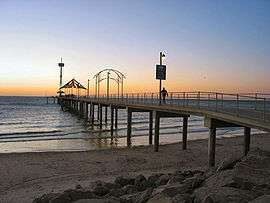Brighton, South Australia
Brighton is a coastal suburb of Adelaide, South Australia, situated between Seacliff and Glenelg and aside Holdfast Bay. Some notable features of the area are the Brighton-Seacliff Yacht Club, the Brighton Surf Lifesaving Club, the Brighton Jetty, and a beach. The Windsor Theatre constructed in 1925 is a long-standing institution, showing cinema to the locals usually two films per night.
| Brighton Adelaide, South Australia | |||||||||||||||
|---|---|---|---|---|---|---|---|---|---|---|---|---|---|---|---|
 Brighton Jetty | |||||||||||||||
| Population | 3,397 (2011 census)[1] | ||||||||||||||
| Postcode(s) | 5048 | ||||||||||||||
| LGA(s) | City of Holdfast Bay | ||||||||||||||
| State electorate(s) | Gibson | ||||||||||||||
| Federal Division(s) | Boothby | ||||||||||||||
| |||||||||||||||
History

Brighton Post Office opened on 27 August 1849. Brighton Jetty Post Office opened on 1 March 1950 and closed in 1979.[2]
Brighton became the seat of a newly-formed municipality, the Corporate Town of Brighton, in 1858.
The first Brighton Town Hall was built in 1869 and was just the fourth Town Hall built in the colony of South Australia. The architect and builder was George William Highet who arrived in the colony in 1836 and served as a town clerk and inaugural councillor. He died in Brighton aged 80 years. The hall was constructed of stone from Ayliffe’s quarry in the Adelaide Hills laid on concrete foundations.[3] It was used as the civic centre of the City of Brighton from 1869 until 1936 when it was then leased by the RSL.
The second town hall was opened in 1937, at 24 Jetty Road, and still fulfils a civic administration purpose.
Brighton was the home of Australian geologist, Antarctic explorer and academic Sir Douglas Mawson. He was buried at St Jude's Church Cemetery in the suburb.
Brighton North Cemetery nearby, at 301 Brighton Road, is the "last resting place" of Catherine Helen Spence and her brother J. B. Spence,[4] Pat Glennon and Paul Moran.[5]
Overview
Brighton has a large sandy beach which is patrolled by the Brighton Surf Lifesaving Club on Weekends and Public Holidays between November and March. Brighton Beach is popular for Adelaide beach goers as it is relatively safe - currently rated as Least Hazardous by Surf Lifesaving.

A sand replenishment program has been in operation for many years resulting in the beach sand dunes gradually increasing through the program of replacing eroded sand and replanting of the dunes with plants and grasses.
In summer, a sandbar normally forms in the water which can produce waves on windy days. Brighton is well known by local surfers for producing messy but fun 'stormy sessions'.
The Esplanade is an area of prime real estate which has been transformed over the years from a street of old cottages to new modern town houses.
Brighton's Jetty Road runs perpendicular to the Esplanade and is home to many restaurants, cafes and the local hotel, known as "The Esplanade", or "Espy".
Brighton jetty
The first Brighton Jetty was built in 1886 and weathered the sea and storms for over 100 years.[6] The Brighton jetty was badly damaged by winter storms in the 1994. The jetty was rebuilt using funds supplied by a mobile phone (cell phone) service provider, hence the tower on the end of the jetty.
In 1926 the women of Brighton erected a drinking fountain near the entrance of the jetty to commemorate the death of Kathleen Duncan Whyte, who was fatally attacked by a shark while swimming. Kitty was the daughter of Rev. Maculley and taught swimming at Brighton for many years. In 1919 Kitty saved a swimmer from drowning and was awarded a Grand Diploma by the Royal Life Saving Society.
At the shore end of the jetty is a War Memorial arch. Here, traditional Dawn Services are held annually on Anzac Day to commemorate fallen service men and women.
- Brighton - Looking northeast from over the water
- Brighton - Looking southeast from over the water
Events and attractions
Brighton is the home of the Brighton Jetty Classic, an Open Water Swim made up of the 1500 metre Brighton Jetty Classic Swim and the 400 metre Jetty Swim, aimed at first time open water swimmers. The Brighton Jetty Classic had its first year in 2006 when approximately 800 swimmers successfully completed the event. It is an annual event, being hosted on the first Sunday in February. The 2010 event had over 1200 swimmers, making it the largest open water swim in South Australia. The course is around the Brighton Jetty, which makes the Jetty a fantastic viewing platform for spectators.
Cement works
Although called Adelaide Brighton Cement, the cement works are actually located in the nearby suburb of Marino.
References
- Australian Bureau of Statistics (31 October 2012). "Brighton (State Suburb)". 2011 Census QuickStats. Retrieved 3 February 2016.

- Premier Postal History. "Post Office List". Premier Postal Auctions. Retrieved 26 May 2011.
- Conservation Management Plan for Former Brighton Town Hall, Flightpath Architects, 2009.
- "Death of Miss Spence". The Evening Journal (Adelaide). South Australia. 4 April 1910. p. 2. Retrieved 30 March 2020 – via Trove.
- "Brighton Cemetery South Australia". Find a Grave. Retrieved 30 March 2020.
- City of Holdfast Bay (2007). Brighton A Walk Through History. https://www.holdfast.sa.gov.au/webdata/resources/files/Brighton%20A%20Walk%20Through%20History%20Brochure.pdf: City of Holdfast Bay. p. 12.CS1 maint: location (link)
External links
- City of Holdfast Bay
- The Brighton Jetty Classic
- The Brighton Surf Lifesaving Club
- Brighton Beach Summary from Surf Lifesaving Australia
| Wikimedia Commons has media related to Brighton, South Australia. |